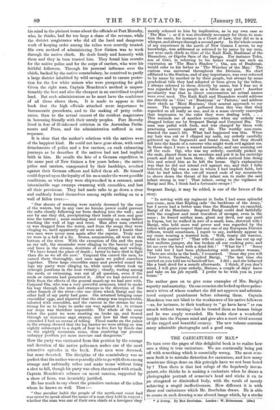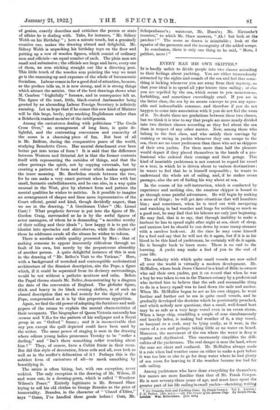THE CARICATURES OF MAX.*
To turn over the pages of this delightful book is to realize how rare a thing is true caricature. We are continually being put off with something which is essentially wrong. The most com- mon fault is to mistake distortion for caricature, and how many wearisome things done on this principle have we not been bored by ? Then there is that last refuge of the hopelessly incem- petent, who thinks he is making a caricature when he draws a photographic portrait of someone's head and sticks it on to an elongated or diminished body, with the result of merely achieving a stupid ineffectiveness. How different it is with these real caricatures which Mr. Beerbohm draws. He is able to create in each drawing acme absurd image which, by a stroke • A Survey. By Max Beerbohm. l ondon : W. Heinemann. Me.] of genius, exactly describes and criticizes the person or state of affairs he is dealing with. Take, for instance, " Mr. Sidney Webb on his Birthday " ; here a minute touch, but a genuinely creative one, makes the drawing absurd and delightful. Mr. Sidney Webb is unpacking his birthday toys on the floor and putting up a row of wooden figures, which consist of ordinary men and officials—an equal number of each. The plain men are small and submissive ; the officials are large and have, every one of them, an arm sticking straight out like a directing post. This little touch of the wooden arm pointing the way we must gods the summing-up and exposure of the whole of bureaucratic Socialism. Labour comes in for a good deal of attention, because, as the preface tells us, it is now strong, and it is strong things which attract the satirist. One of the best drawings shows what M. Cambon " frightfully " foresaw, and in consequence left us. The figure of the neat, little, black-coated Ambassador being greeted by an abounding Labour Foreign Secretary is infinitely amusing. Let us hope that if he comes this new kind of Minister will be this large, beefy, pipe-smoking Englishman rather than a Bolshevik-trained member of the intelligentsia.
Among the caricatures dealing with politicians " The Cecils Cross Over," an arrangement of long lines, is quite de- lightful, and the contrasting convexness and concavity of the noses is a charming piece of fun. But best of all is Mr. Balfour, during the comparative peace of the world, studying Benedetto Croce. Has mental detachment ever been better put into terms of form ? It is said that the difference between Western and Oriental Art is that the former contents itself with representing the outsides of things, and that the other portrays the spirit, not by copying externals, but by creating a pattern of form and colour which makes apparent the inner meaning. Mr. Beerbohm stands between the two, for he can make a very exact portrait when he likes with but small, fantastic embellishments, and he can also, in a way quite unusual in the West, give by abstract form and pattern the mental qualities he wishes to satirize. Is it possible to imagine an arrangement of shapes and lines more representative of the Court official, genial and kind, though decidedly august, than we see in the drawing, " A Gentleman Usher " (Mr. Lionel Oust) ? What prophetic fervour is put into the figure of Mr. Gordon Craig, surrounded as he is by the awful figures of actor managers, of whom he is demanding " a sacrifice worthy of their calling and their ideals " ; how happy it is to put the idealist into spectacles and shirt-sleeves, while the clothes of those he addresses exude all the abuses he wishes to reform.
There is another subtle quality possessed by Max : that of making someone to appear innocently ridiculous through no fault of his own, but merely by the preposterous absurdity of another person. A quite delightful instance of this is seen in the drawing of " Mr. Belloc's Visit to the Vatican." Here, with a background of wretched and contemptible ecclesiastical architecture of the flimsiest description, sits the Pope, a figure which, if it could be separated from its derisory surroundings, would be not without a pathetic neatness and calm. Before the Papal throne stands Mr. Belloc, demonstrating by a diagram the date of the conversion of England. The globular figure, thick and heavy in its black evening clothes, is of such an absurd description that we feel acutely for the dignity of the Pope, compromised as it is by this preposterous apparition.
Again, we find the old power of adapting the furniture and wall- papers of the rooms to explain the mental characteristics of their occupants. The biographer of Queen Victoria naturally has Drowns and V.R.s for the pattern of his wallpaper and a Royal group in an " Oxford " frame ; and it is inconceivable that any pen except the quill depicted could have been used by the writer. The same power of staging is seen in the drawing where odious young ladies pronounce Trotsky to be " rather a darling," and " Isn't there something rather touching about him ? " They, of course, have a Cubist frieze in their room. But did this style of decoration, frieze sofa and all, ever look so well as in the scoffer's delineation of it ? Perhaps this is the subtlest form of caricature of all—to mock something by beautifying it.
The satire is often biting, but, with one exception, never unkind. The only exception is the drawing of Mr. Wilson, ill and worn out, in a dressing-gown, which is called " Woodrow Wilson's Peace." Entirely legitimate is Mr. Bernard Shaw trying to sell his old clothes to George Brandes as the price of immortality. Brandes, in the character of "'Chard d'Idees," says " Come, I've handled these goods before I Coat, Mr.
Schopenhauer's ; waistcoat, Mr. Ibsen's ; Mr. Nietzsche's trousers," to which Mr. Shaw answers, " Ah ! but look at the patches ! " The scene as drawn is inimitable ; look at the squalor of the garments and the incongruity of the added scraps. In conclusion, there is only one thing to be said, " More, I prithee, more ! "



































 Previous page
Previous page